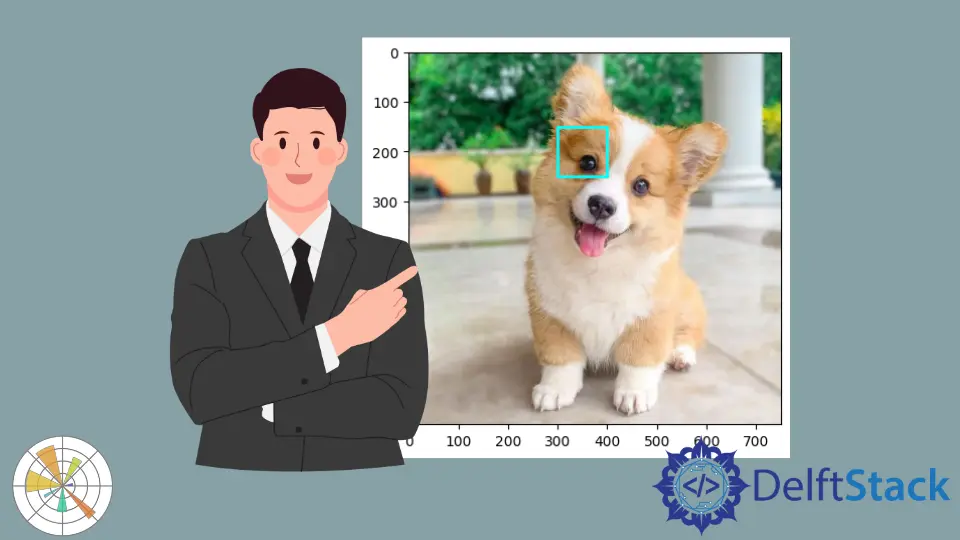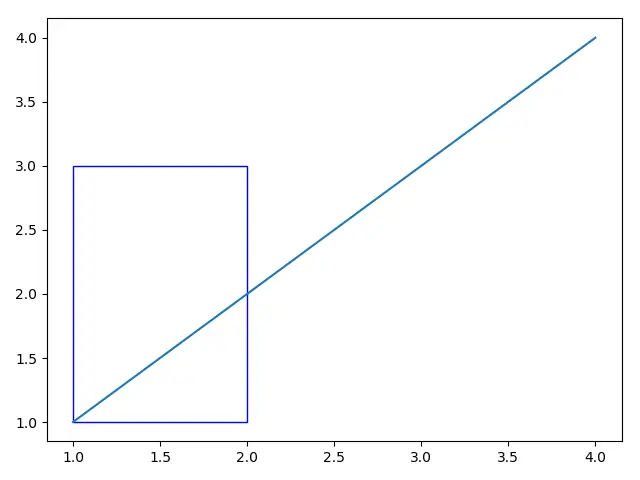Matplotlib 中如何在图像上绘制矩形

当我们需要在 Matplotlib 中的图像或纯图形上绘制矩形时,应通过 add_patch 方法将 matplotlib.patches 中的 rectangle patch 添加到轴上。
matpotlib patch 是具有外观和边缘颜色的 2D artist。Matplotlib 具有如下的 patch,
ArcArrowArrowStyleBoxStyleCircleCirclePolygonConnectionPatchConnectionStyleEllipseFancyArrowFancyArrowPatchFancyBboxPatchPatchPathPathPatchPolygonRectangleRegularPolygonShadowWedge
Rectangle patch 绘制一个指定左下角坐标和指定宽度和高度的矩形。
Rectangle(xy, width, height, angle=0.0, fill=True, **kwargs)
xy 是一个长度为 2 的元组,用于指定要绘制的矩形的左下角的坐标,
width 是矩形的宽度
height 是矩形的高度,
angle 是逆时针角度,以度为单位。
fill 指定矩形是否用 facecolor 填充。
一些有效的 kwargs 如下,
edgecolor:矩形边缘的颜色facecolor:矩形的填充色
在 Matplotlib 中绘制矩形
import matplotlib.pyplot as plt
import matplotlib.patches as patches
fig, ax = plt.subplots()
ax.plot([1, 4], [1, 4])
ax.add_patch(
patches.Rectangle((1, 1), 0.5, 0.5, edgecolor="blue", facecolor="red", fill=True)
)
plt.show()
矩形 patch 由构造函数创建,
patches.Rectangle((1, 1), 1, 2, edgecolor="blue", facecolor="red", fill=True)
其左下角的坐标为 (1, 1),其宽度为 1,高度为 2。
边缘颜色指定为 blue,同时填充颜色为 red。
轴对象的 add_patch(P) 方法在轴上添加一个 Patch。

如果将 fill 设置为 False,即使 facecolor 已经指定了某些颜色了,矩形也不会被填充。
import matplotlib.pyplot as plt
import matplotlib.patches as patches
fig, ax = plt.subplots()
ax.plot([1, 4], [1, 4])
ax.add_patch(
patches.Rectangle((1, 1), 1, 2, edgecolor="blue", facecolor="red", fill=False)
)
plt.show()

在 Matplotlib 中的图像上绘制矩形
如果我们需要在 Matplotlib 中的图像上绘制一个矩形,则它与上述方法类似,但是需要额外的步骤来获取轴 Axes 句柄。
import matplotlib.pyplot as plt
import matplotlib.patches as patches
from PIL import Image
im = Image.open("butterfly.jpg")
plt.imshow(im)
ax = plt.gca()
rect = patches.Rectangle((80, 10), 70, 100, linewidth=2, edgecolor="cyan", fill=False)
ax.add_patch(rect)
plt.show()
plt.imshow(im) 显示图像 butterfly.jpg,而轴 Axes 的句柄可以通过函数 plt.gca() 获得,gca 是获取当前轴 get current axes 的首字母缩写。

Founder of DelftStack.com. Jinku has worked in the robotics and automotive industries for over 8 years. He sharpened his coding skills when he needed to do the automatic testing, data collection from remote servers and report creation from the endurance test. He is from an electrical/electronics engineering background but has expanded his interest to embedded electronics, embedded programming and front-/back-end programming.
LinkedIn